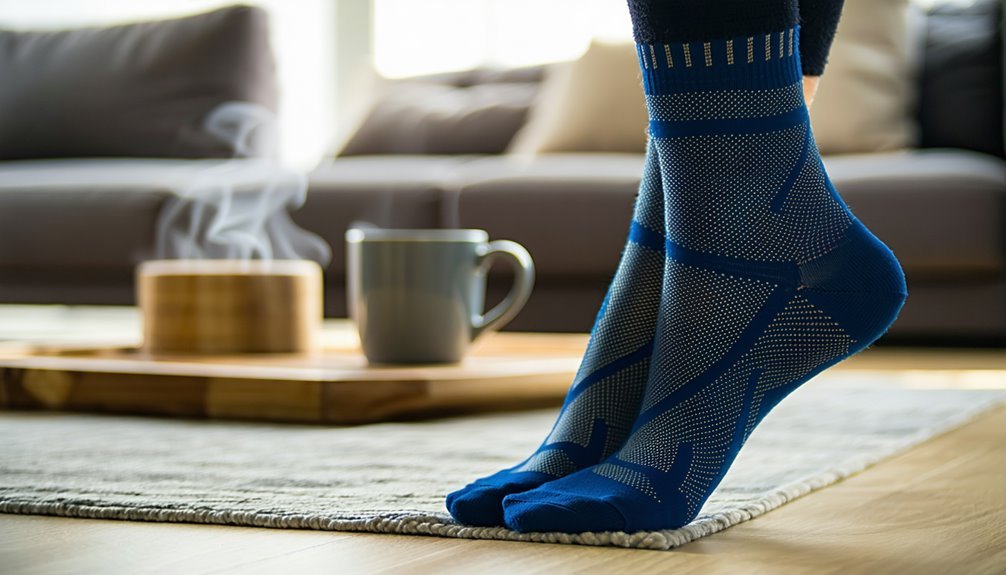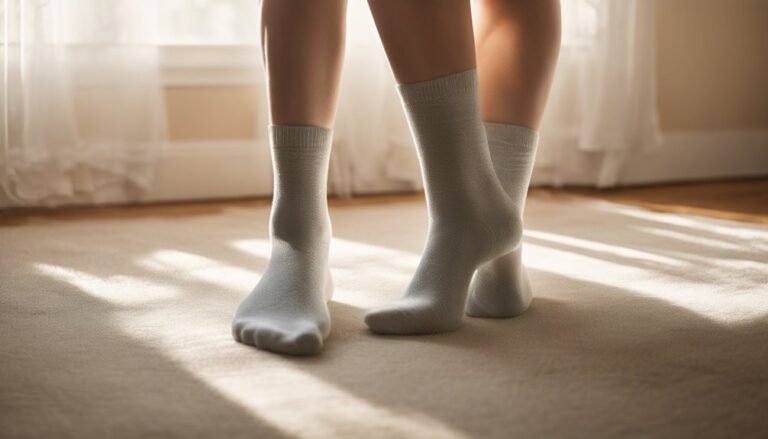How Long Can You Wear Compression Socks
You can wear compression socks for different durations depending on your needs and comfort. Typically, start with shorter periods and gradually increase wear time as you become more accustomed to them. Factors like the type of socks and your activity level can influence how long you should wear them. Always monitor your comfort and look out for any adverse signs that may indicate it's time to remove them. Discover more about the benefits and guidelines for wearing these socks.
Understanding Compression Socks
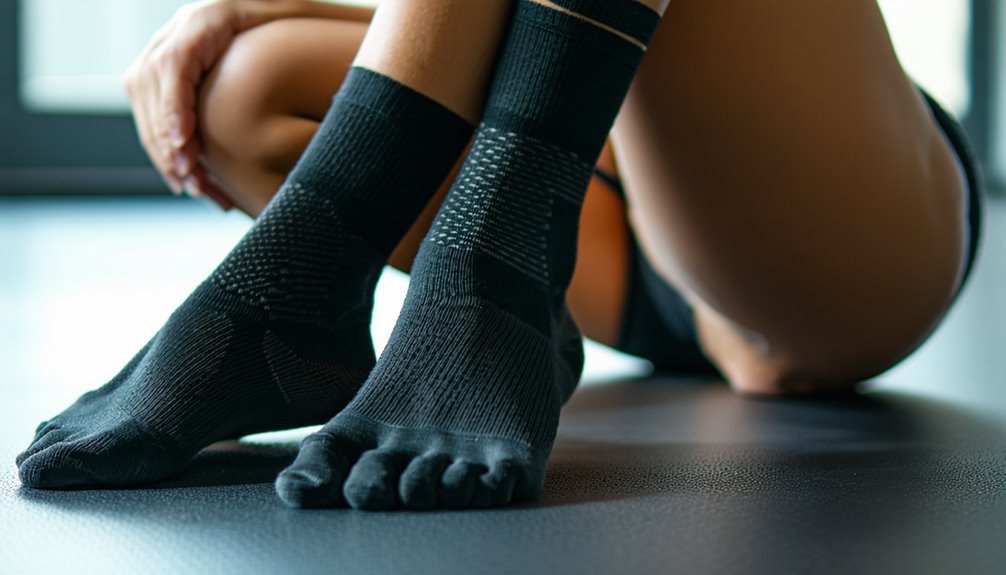
Compression socks are specially designed garments that apply gentle pressure to your legs and feet. They're made from various compression sock materials, including nylon, spandex, and natural fibers, providing durability and comfort. The level of compression varies, guaranteeing you can choose the right fit based on your needs.
You'll find several compression sock styles, such as knee-high, thigh-high, and full-leg options. Each style serves different purposes, whether you're looking to improve circulation during long flights or manage chronic conditions. It's crucial to select the appropriate material and style to guarantee maximum safety and effectiveness. Understanding these factors will help you make informed decisions about incorporating compression socks into your daily routine for support and comfort.
Benefits of Wearing Compression Socks
Wearing compression socks can provide numerous benefits for your overall leg health and comfort. One of the primary health benefits is improved circulation. By applying graduated pressure, these socks help promote blood flow back to the heart, reducing the risk of blood clots and varicose veins. This is especially important for those who sit or stand for long periods. Additionally, compression socks can alleviate swelling and fatigue in the legs, making them ideal for athletes and travelers alike. They also offer support during recovery from injuries or surgeries, enhancing your overall mobility. By incorporating compression socks into your daily routine, you can experience significant circulation improvement and enjoy enhanced leg comfort throughout the day.
Types of Compression Socks
When it comes to compression socks, variety is essential to meet different needs and preferences. You'll find two primary types: graduated compression and therapeutic compression. Graduated compression socks are designed to apply the most pressure at the ankle, gradually decreasing up the leg. This design promotes blood flow and helps prevent swelling, making them ideal for daily wear or long periods of standing. On the other hand, therapeutic compression socks offer consistent compression levels, often used for medical conditions like varicose veins or post-surgery recovery. Choosing the right type depends on your specific needs, lifestyle, and any medical advice you've received. Always consult with a healthcare professional to guarantee you're selecting the right option for your safety and comfort.
Factors Affecting Wear Time
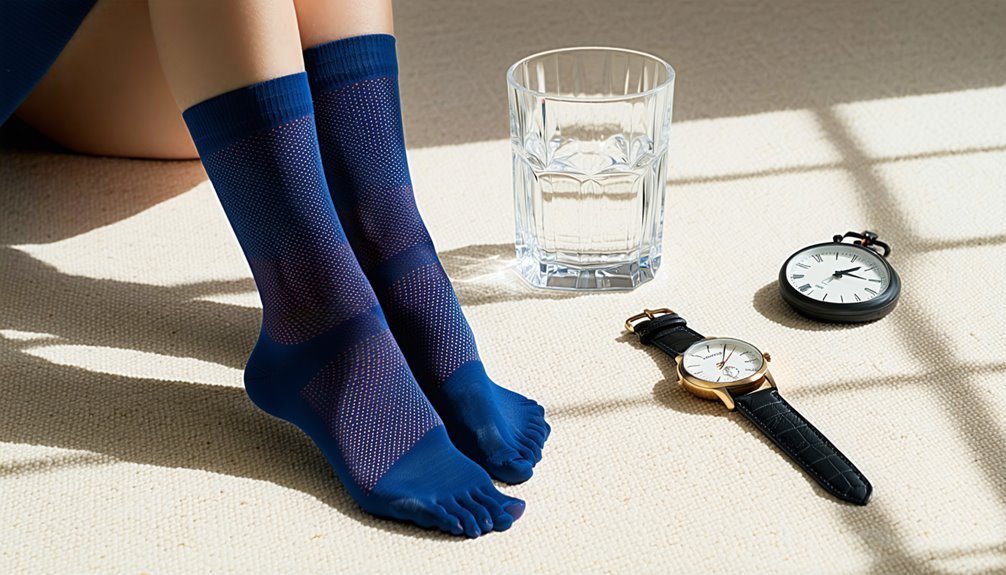
Several factors can influence how long you should wear compression socks, including the type of socks, your activity level, and any specific health conditions. The compression level plays a significant role; higher levels may be suitable for specific medical conditions but can also lead to discomfort if worn too long during low activity. Your individual activity is equally important; if you're engaging in prolonged standing, wearing them longer may be beneficial. Conversely, if you're mostly sedentary, shorter wear times might suffice. Always consider any underlying health issues, as they can dictate your wear time. Listening to your body is essential; if you experience discomfort, it's wise to remove the socks and consult a healthcare professional for personalized advice.
Recommended Wear Duration
While individual needs can vary, a general recommendation for wearing compression socks is between 6 to 8 hours daily. This recommended wear duration guarantees you reap the benefits without risking discomfort or complications. For most people, wearing them during the day, particularly while standing or sitting for long periods, can help improve circulation and reduce swelling. Remember, daily usage is key to experiencing the full advantages of compression therapy. If you're new to wearing compression socks, start with shorter periods and gradually increase the time as your body adjusts. Always consult with a healthcare professional to determine the best duration for your specific needs, as they can provide tailored advice based on your health status and lifestyle.
Signs You Should Remove Compression Socks
If you experience discomfort or pain while wearing compression socks, it's important to think about removing them. Additionally, watch for any noticeable changes in your skin, such as redness or irritation. These signs can indicate that your socks may not be fitting properly or need to be taken off.
Discomfort or Pain
Although compression socks are designed to improve circulation and provide support, discomfort or pain can indicate that it's time to remove them. It's essential to listen to your body, as ignoring signs of compression discomfort may lead to more serious issues. Here are some signs you should consider for pain management:
- Persistent aching or throbbing in your legs
- Numbness or tingling sensations
- Visible swelling that doesn't subside
- Skin irritation or redness
If you experience any of these symptoms, it's wise to take off your compression socks and consult a healthcare professional. Your safety and comfort should always come first, and addressing any pain or discomfort promptly can help prevent complications.
Skin Changes Observed
Discomfort isn't the only indicator that it's time to remove your compression socks; skin changes can also signal a problem. Pay attention to any signs of skin irritation or color changes, as these may indicate that the compression level is too high or the socks are not fitting properly.
| Skin Change | Action Required |
|---|---|
| Redness | Remove socks immediately |
| Rash | Consult a healthcare provider |
| Color changes (e.g., blue or pale) | Remove socks and seek advice |
| Swelling | Remove socks and elevate feet |
If you notice any of these changes, it's essential to act promptly. Ignoring these signs could lead to more serious complications. Always prioritize your skin health.
Tips for Comfort and Effectiveness
To guarantee comfort and effectiveness, it's essential to choose compression socks that fit properly. Start by measuring your legs to find the right size and level of compression. Additionally, gradually increase the time you wear them to help your body adjust.
Proper Fit Matters
Finding the right fit for your compression socks is essential for both comfort and effectiveness. A proper fit assessment guarantees that your socks provide the intended benefits without causing discomfort. Here are some tips for ideal sock selection:
- Measure your legs accurately, considering both circumference and length.
- Choose the right compression level based on your healthcare provider's advice.
- Make sure there's no pinching or excessive tightness, which can lead to complications.
- Consider the fabric and style that best suits your daily activities.
Gradual Wear Increase
While it might be tempting to wear your compression socks for extended periods right away, gradually increasing wear time is essential for comfort and effectiveness. Start by wearing them for just a couple of hours each day, then slowly extend this duration as your body adjusts. This gradual increase helps you build wear tolerance, making it easier to wear them for longer periods without discomfort. Pay attention to how your legs feel during this process; if you experience any pain or excessive tightness, reduce the wear time and consult a healthcare professional. By allowing your body to adapt, you'll enhance the benefits of compression socks while ensuring your comfort and safety.
Common Misconceptions
Many people mistakenly believe that compression socks are only necessary for athletes or those with specific medical conditions. However, this is one of many compression sock myths that need addressing. Misconceptions clarified include:
- Compression socks can benefit anyone who stands or sits for long periods.
- They're not just for recovery; they can enhance circulation and reduce fatigue.
- You don't have to wear them only during exercise; they're suitable for daily use.
- Compression levels vary; not all socks provide the same support.
Understanding these points can help you make informed decisions about your health. Whether you're active or sedentary, compression socks might be a valuable addition to your routine. Always consult a healthcare professional if you have specific concerns.
When to Consult a Healthcare Professional
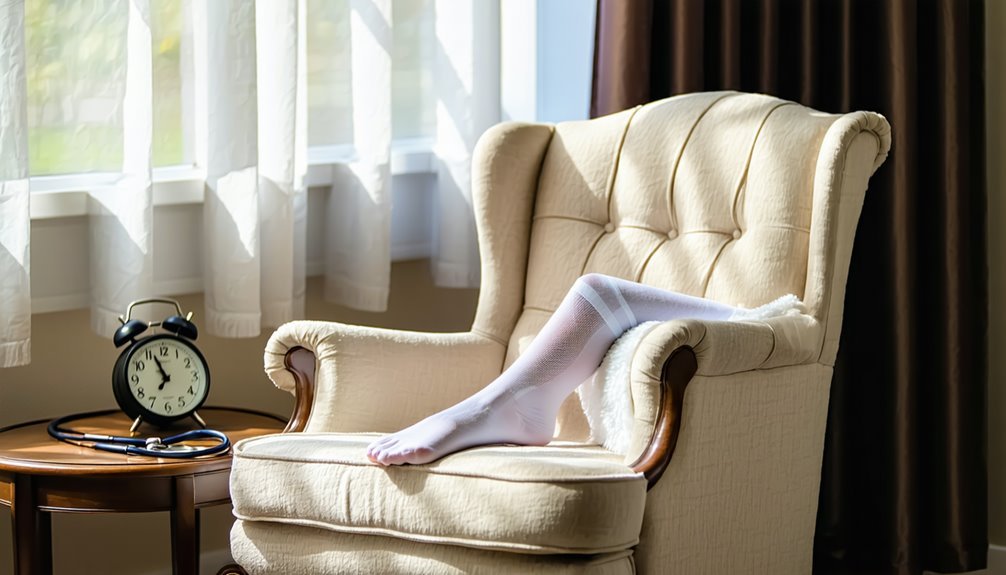
Wondering when you should seek advice from a healthcare professional about wearing compression socks? It's essential to recognize consultation indicators. If you experience persistent pain, swelling, or discomfort, it's time to consult a professional. Additionally, if you notice any skin irritation or unusual changes in your leg appearance, don't hesitate to seek advice.
| Consultation Indicators | Action |
|---|---|
| Persistent pain | Consult a healthcare professional |
| Skin irritation | Seek professional advice |
| Swelling not improving | Schedule a consultation |
Always prioritize your safety. Compression socks can provide benefits, but improper use may lead to complications. When in doubt, getting professional advice guarantees you're using them correctly.
Frequently Asked Questions
Can I Wear Compression Socks While Sleeping?
You can wear compression socks while sleeping, but it's important to take into account your comfort. Sleeping benefits include improved circulation, though be mindful of the compression duration to avoid potential discomfort or skin irritation during the night.
Do Compression Socks Come in Different Sizes?
Yes, compression socks come in different sizes to guarantee a proper fit. It's essential you refer to a measuring guide to find your size variations, enhancing comfort and effectiveness while promoting safety during wear.
How Do I Choose the Right Compression Level?
Choosing the right compression level's like picking a key for a lock; it opens the benefits of circulation. Consider your needs and styles available, ensuring you balance comfort with the support your body requires for safety.
Can I Wash and Reuse Compression Socks?
Yes, you can wash and reuse compression socks. Use gentle cleaning methods to maintain sock lifespan. Regular washing helps prevent bacteria buildup, ensuring safety and effectiveness, so always follow the manufacturer's care instructions for best results.
Are Compression Socks Safe for Everyone to Wear?
Think of compression socks as a protective shield. They're beneficial for many, but not everyone should wear them, especially those with certain medical conditions. Always consult a healthcare professional before trying them on for safety.

